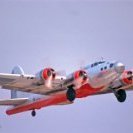Search the Community
Showing results for tags 'glider'.
-
Placeholder whilst I finish putting a full in-box review together - this will be a fairly quick (hopefully) build in coming weeks. As an ex. Air Cadet myself (who ended up commanding a squadron as an adult) I'm really drawn by this subject, even though my early gliding was in a different type. This is a very high quality 3D printed kit, designed and made by our own Tim Perry (@wunwinglow) and shortly available to order. Will post a link to the review when I put 'live' but, in the mean time, a wee taster: "All clear above and behind - take up slack - all out!" Iain
- 101 replies
-
- slingsby
- air cadets
-
(and 2 more)
Tagged with:
-
Hello folks, Last year I was the lucky winner of a model kit in the LSP raffle. Iain kindly donated this Revell kit of the ASK 21 glider which fits in perfectly with this GB. https://www.bing.com/images/search?q=Revell+ASK21+glider&qpvt=Revell+ASK21+glider&qpvt=Revell+ASK21+glider&qpvt=Revell+ASK21+glider&FORM=IGRE Civilian aircraft are not my usual fare so this is an ideal opportunity to try something new. For now this is a space setter post but I'll be back with more as soon as I get the box open. Cheers.
-
Hi guys, Sorry for the lack of photos, I've not really documented this build but posting up here as it might be of interest. It's not a kit I've ever seen built before, which was one of the reasons why I'm building it, that and I've had it since I was a little boy and always wanted to own a built Gigant! Will keep this updated from now on.... I'm aiming to get this done for Cosford which is a couple of months away. Thanks for looking
-
Hi folks, I've been working on this little project for a while, my first injection moulded kit, subject the T31 training glider used for several decades by the Air training Corps gliding schools. I've done pretty much all the kit design, including decals, and have had several 3D printed sets of parts made to check assembly. I'll have these on show, with some CAD images, at the forthcoming ScaleModelWorld show at Telford. If you are there, do call by and have a look if you can. Scale is 1:32 so it will match the Revell glider kits, and a whole lot more besides! Kit will be injection moulded, as finely detailed as I can manage while keeping it sensible for moulding. Decals will cover a number of different colour schemes, and enough code characters will be included so you can finish the model as 'YOUR' aircraft. I should stress this is still just a kite flying exercise at the moment, but all the hard work is done on the design. I'll be showing progress so far at Telford with a view to assessing financial viability and interest, before looking at funding the tooling. More details shortly..... Tim Perry
- 11 replies
-
- T31
- Air Cadets
-
(and 2 more)
Tagged with:
-
1/18 scale Instytucie Szybownictwa IS-A Salamandra 53 3D printed / scratchbuilt model The text following is to describe the 1/18 scale Instytucie Szybownictwa IS-A Salamandra 53 (1953 version) glider model building, as produced by aviation factories throughout Poland.
- 60 replies
-
- 3d printed
- anyuta 3d
- (and 5 more)
-
1/18 scale Hafner Rotabuggy flying Jeep Willys Royal Air Force 1943 Solido diecast conversion & scratchbuilt The Hafner Rotabuggy (formally known as the Blitz Buggy or Malcolm Rotaplane) was an experimental aircraft that was essentially a jeep (actually a Willys MB) combined with an autogyro. It was designed by Austrian born British designer Raul Hafner of the AFEE - Airborne Forces Experimental Establishment after their development of the Hafner Rotachute enjoyed some success. The prototype was built by the M.L. Aviation Company at White Waltham in 1942. One of several failed concepts for the equipping airborne forces, the effort and risk in getting the Rotabuggy into battle would probably have outweighed its utility. Initial testing showed that a Willys MB could be dropped from heights up to 2.35 metres (7.7 ft) without damage to the vehicle. A 12.4 metres (40.7 ft) diameter rotor was attached, along with a tail fairing and fins, but no rudders. The design work was carried out by AFEE staff, while most of the construction was undertaken by R. Malcolm Ltd, with H. Morris & Sons assisting in the manufacture of the rubber hub. The serial numbers RD123 and RD127 were allotted for the two Malcolm Blitz Buggys, although they were never to be used. The basic Jeep was fitted with a pylon to support the two-bladed rotor and a fairing to carry the tail surfaces. The Hafner Rotabuggy, as it became known, was to carry a pilot and a small load, together with a complete tankage of fuel and spare wheel, spare tank, tools and snow chains. The pilot occupied the starboard front seat, but an alternative arrangement for a second pilot was made in the port seat with dual controls. The tail fairing was a plywood monocoque structure attached at four points to the rear of the Jeep and cabin. Because consideration loads were transmitted through the fairing in some conditions of flight and in heavy landing, the Jeep was strengthened locally at the points of attachment. The twin-spar tailplane had trimming flaps on either side which were adjustable on the ground by means of turnbuckles. Large endplate fins were set at a slight angle in plain view to give incidence relative to the local airflow. Replacing the standard Jeep windscreen was a streamlined sheet metal framework with perspex sheets. The remainder of the cabin was built of plywood. Access doors with large perspex panels were fitted both sides. A hole in the cabin roof accommodated the pylon, with allowances for movement owing to the elastic suspension. In the cockpit a special dashboard on the starboard side contained an airspeed indicator, a rotor speed indicator, a sensitive altimeter and a turnand- slip indicator. A standard telephone system via the towrope allowed the pilot to communicate with the tug pilot, the amplifier and batteries being located behind the starboard seat. The Hafner Rotabuggy, camouflaged, carrying RAF roundels and a prototype “P”.





